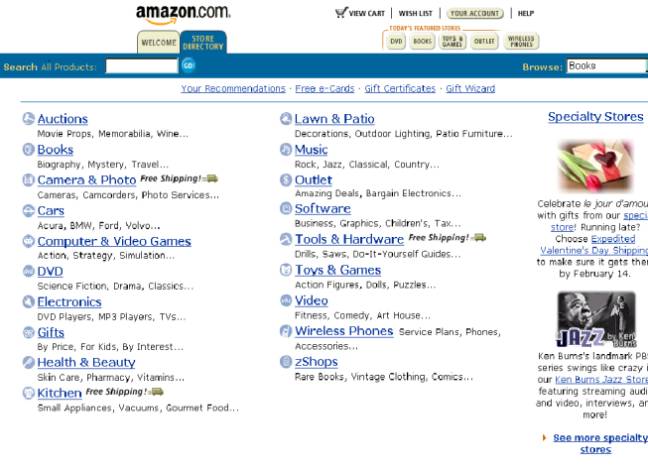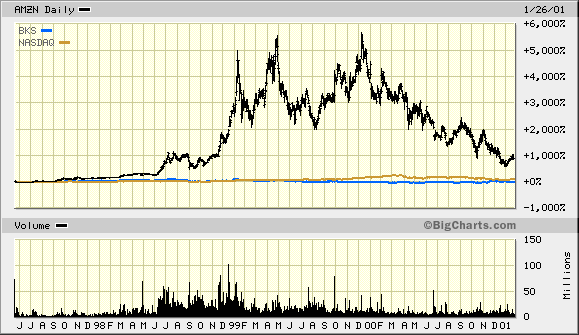









|
Amazon
Amazon.com Inc. is an online retailer that serves
over 17 million customer accounts in over 150 countries. The products that
Company sells range from books, music and DVDs to toys, electronics,
software, video games and home improvement products.
Amazon.com also provides marketplace services such as
Amazon.com Auctions, zShops and sothebys.amazon.com. Such marketplace
services allow the buyers and sellers to come together on the Cyberspace
to make transactions happen, irrespective of time and place. With the
Internet, these marketplace services transcend the limits of time and
geographical boundaries.
Being a representative company in the newly emerged
field of e-commerce, Amazon.com, the largest online retailer that has a
heavy reliance on the Internet technology, has proven to be one of the
most prominent technology leaders in the field. Significant investments of
the Company are in the area of engineering new user-friendly software.
Some of its remarkable innovations include the 1-Click technology,
personalized shopping services, powerful easy-to-use search engines as
well as other browse features and wireless access to the Company’s
stores.
Is Amazon.com an economic bubble then?
Before coming to a conclusion, we shall take a closer look at this
NASDAQ-listed company.

3 Segments of Business
First founded as an online bookstore, Amazon.com has
developed rapidly and diversified its businesses. The Company is now
primarily organized into 3 major operating segments,
US Books, Music
and DVD/Video Segment – Over 13 million titles in books, music and
DVD/video are offered for sale on the web page now. As a highly
customer-oriented company, Amazon.com has expanded its bookstore and
diverted lots of resources to enhance the customer’s shopping
experience. Just in the year 1999, the Company, in partnership with
experts in certain fields, enriched its editorial content and introduced
new specialty stores such as its professional and technical store.
Millions of out-of-print titles are still available
at the store. In order to have a more in-depth understanding of how
immense the collection of titles is at Amazon.com, our project research
team attempted to find several very outdated CD singles from a local Hong
Kong singer, Jacky Cheung. Surprisingly enough, all are still available at
Amazon.com, though at rather high prices. Another notable achievement of
the Music store is that it is in fact the first major online music
retailer to dedicate an area of its store to free, full-length song
downloads from established artists and major-label performers.
Consequently, both the Music store and DVD/video store have seen
significant upsurge in total revenue. Product recommendations services
were improved at the Music Store while the DVD/video store continued its
integration with its Internet Movie Database (IMDb) Web site, a leading
online information source for movie enthusiasts. The Company has also
created and hosted several official web sites for a number of popular
movies such as “American Beauty”.
International
Segment – In the year 1999, the Company used to have only two
internationally focused web sites, www.amazon.co.uk and www.amazon.de. By
now, the number of international sites has grown to 4, with the addition
of www.amazon.co.jp and www.amazon.fr. Both amazon.co.uk and amazon.de
were ranked the number one most visited e-commerce site and the number 10
most visited site overall in the United Kingdom and Germany, respectively,
according to the Media Metrix ratings for Europe released in January 2000.
Services and products offered by these international sites are tailor-made
for the local markets.
Others Segment
– This segment includes all other areas of businesses like the
Wireless Phones, Gifts, and the aforementioned marketplace services like
zShops and Auctions. The sectors that perform best in this segment are
undoubtedly the marketplace services. During the fourth quarter of 1999,
these marketplace services surpassed a combined 1 million registered users
and 1.5 million listings. Since its launch in November 1999,
sothebys.amazon.com has achieved average close rates, which are rates of
actual purchases by customers bidding at the site, in excess of 50% and
average auction closing prices of over $500.

Technology
Web Site Format
– Amazon.com is mostly written in html, the most widely accepted
language for homepage publication, though not the one that produces the
best multimedia effects.
1-Click
Shopping – 1-Click Shopping is an innovation of Amazon.com, which
sets it apart from its competitors in the online shopping industry.
Once the customer has placed his/her first order with Amazon.com,
1-Click shopping can be turned on, such that to buy an item only requires
1 click on the item. Then the
customer’s credit card will automatically be debited and the item
shipped to the pre-registered address in due course.
Such a technology has significantly made online shopping easier and
has largely contributed to the unprecedented growth rates in revenues of
the Company.
Security over
Payments – The greatest concern over the transactions on the
Internet has always been security. Since
transactions carried out over the Internet mostly rely on credit cards,
proper encryption methods are required for secure transmission of personal
data. Amazon.com assures its
customers of security by offering the Amazon.com Safe Shopping Guarantee,
which basically guarantees that it would cover all the liability of
fraudulent credit card charges out of shopping at Amazon.com.
The encryption method used is the popular industry security
standard called 128-bit Secure Socket Layer (SSL), which encrypts the
customer’s personal information including credit card number, name, and
address, so that it cannot be read as the information travels over the
Internet.


Amazon.com Inc. is traded in the US stock market
under the symbol AMZN. It is probably the most volatile in the pool of
constituent stocks of NASDAQ. Its IPO was in May 1997, about a year before
the series of upsurges of share prices of the dotcom companies. In the
first year of its trading, the Company’s shares were traded at price
range under $10 and the Company was showing steady and sustainable growth,
without any observable dramatic fluctuations in its share price. However,
between Sept 98 and May 99, its share price skyrocketed from around $10
per share to over $110, a remarkable increase of 1100% within 9 months.
The peak value of the Company’s stock was attained in Dec 1999, when the
whole market was investing in Internet stocks speculatively. Its peak
value is $113 and is more than 5500% higher than its price at its IPO!
After that, panic hit due to the frequent release of information on
the Company’s huge amounts of losses. The share price of the Company
dropped by 90% of its peak value to the price range of around $10 to $20
per share.

Amazon.com was admittedly a pioneer in using the
Internet to change a distribution channel.
Yet, think about it: the demand for books and other goods on sale
on Amazon’s homepage has not increased and probably never will. Though Amazon.com has made the transactions over the Internet
much more efficient, given the fact that the demand for the types of goods
on sale has not changed, why should their stock price skyrocket?
Their stock price should not be based on the growth and potential
of the Internet, other than its effect on Amazon.com’s market share and
its potential increase within the respective markets.
Therefore, should Amazon.com be worth more than existing
booksellers, which own assets of higher liquidity like book stores and
land? Compare the share price
with Barnes & Noble, Inc., which is another major bookseller in the US
(plotted in blue). Barnes
& Noble are also of course on the Internet now.
Which then should be worth more?
Was the market rational?

A decline in losses is predicted in 2000 at Amazon.com. The current
forecast expects losses will decrease from 1999's per share figure of
$-2.20 to $-1.19. At this time, losses are expected to again decline in
2001, with losses in the area of $-0.69 are considered likely.
According to most of the analysts’ reports, the investment
community's confidence in the earnings forecast is at the top of the scale
statistically. Yet, any significant variation of actual results from
expectations could have a very adverse effect on the price of company
shares.

The dramatic rise and fall of Amazon’s share price
is indeed attributable to the irrationality that prevailed in the market
in the last year or two. Admittedly,
Amazon.com has a lot of potentials to become the most influential online
seller, yet its share price was artificially pushed to an irrational high
due to speculative activities and market sentiments.
Given the fact that Amazon.com is not creating any demand, its
rational value should never be overwhelmingly higher than its competitors
like Barnes & Noble. From
this perspective, it can be seen that Amazon.com indeed was a bubble, and
that the bubble has already burst.
|